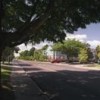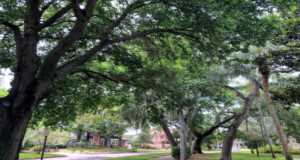This new 13-page article combines canopy coverage data from all of Florida’s metropolitan and micropolitan areas with ecological models developed by the USDA Forest Service to calculate several key benefits of urban trees and an approximation of their monetary value. Benefits of urban trees include carbon sequestration/storage, air pollution filtration, and stormwater mitigation. Written by Drew C. McLean, Andrew K. Koeser, Deborah R. Hilbert, Shawn Landry, Amr Abd-Elrahman, Katie Britt, Mary Lusk, Michael G. Andreu, and Robert J. Northrop, and published by the UF/IFAS Environmental Horticulture Department.
https://edis.ifas.ufl.edu/ep595
Tag: Urban Forestry
How Much Space Does My Shade Tree Need? Planting Space Recommendations for Medium and Large Trees in Florida Cities
Trees provide urban landscapes with shade, beauty, and habitat. They can also help lessen the effects of flooding and urban heat buildup while storing carbon dioxide, a major greenhouse gas. When planted in the wrong place, however, trees can damage urban infrastructure. To maximize the benefits provided by urban trees, we need better-informed tree selection and larger planting spaces with the capacity to support big-canopy trees. This new 8-page fact sheet is intended to help arborists, urban foresters, landscape designers, landscapers, and anyone else responsible for the planting of trees in developed areas make informed decisions regarding the planting width requirements of the trees they select. Written by Deborah R. Hilbert, Andrew K. Koeser, Brooke L. Moffis, JuWanda G. Rowell, and Drew C. McLean, and published by the UF/IFAS Environmental Horticulture Department.
https://edis.ifas.ufl.edu/ep592
Urban Tree Selection for Diversity
Urban tree diversity is important when attempting to create a healthy, beneficial, and resilient urban forest. Having a variety of trees can increase the aesthetic value for residents and create habitats for plants and animals. Some common street trees currently in the landscape are not site-appropriate and create infrastructure damage. By planting different types of trees in these locations, maintenance costs and infrastructure damage can be reduced and tree longevity increased. This new 4-page fact sheet is intended to provide urban foresters, arborists, landscape designers, and others in charge of tree planting with a process for introducing new species into the urban environment. Written by Deborah R. Hilbert, Andrew K. Koeser, and Robert J. Northrop, and published by the UF/IFAS Environmental Horticulture Department.
https://edis.ifas.ufl.edu/ep589
The Costs of Managing an Urban Forest (FOR217/FR279)
 Urban forests provide benefits to society often referred to as ecosystem services: they improve human health, environmental quality, and local economies by increasing property values and aesthetics in communities. They help cities control storm water, reduce air pollution and energy costs, and offset carbon dioxide emissions. But urban forests also have “ecosystem disservices.” An accurate assessment of an urban forest’s costs can assist decision makers to better understand the role the forest plays in improving the well-being of the community. Identifying how funding is used can also help communities minimize costs and increase benefits. This 4-page fact sheet will review some of the types of costs associated with urban forests and present typical financial costs associated with urban forest management in the city of Gainesville, Florida. Written by Francisco Escobedo and Jennifer Seitz, and published by the UF Department of School of Forest Resources and Conservation, October 2012.
Urban forests provide benefits to society often referred to as ecosystem services: they improve human health, environmental quality, and local economies by increasing property values and aesthetics in communities. They help cities control storm water, reduce air pollution and energy costs, and offset carbon dioxide emissions. But urban forests also have “ecosystem disservices.” An accurate assessment of an urban forest’s costs can assist decision makers to better understand the role the forest plays in improving the well-being of the community. Identifying how funding is used can also help communities minimize costs and increase benefits. This 4-page fact sheet will review some of the types of costs associated with urban forests and present typical financial costs associated with urban forest management in the city of Gainesville, Florida. Written by Francisco Escobedo and Jennifer Seitz, and published by the UF Department of School of Forest Resources and Conservation, October 2012.
http://edis.ifas.ufl.edu/fr279
Orlando, Florida’s Urban and Community Forests and Their Ecosystem Services (FOR290/FR358)

Urban forests, or the trees and shrubs on these land uses, play an important role in providing ecosystem services and are often key components in urban planning and management as well as in environmental regulations. This 10-page fact sheet provides information, based on an assessment of urban forests within the limits of the City of Orlando was conducted during the summer of 2010, on the structure and composition of Orlando's urban forest, the occurrence of invasive trees in the city, the ecosystem services trees provide, including estimating the mitigation of climate change effects and their role in urban hydrology, and how this information can be used to define sustainable urban planning objectives and goals. Written by Edem Empke, Elizabeth Becker, Jessica Lab, Ross Hinkle, and Francisco Escobedo, and published by the UF Department of School of Forest Resources and Conservation, February 2012.
http://edis.ifas.ufl.edu/fr358
Miami-Dade County’s Urban Forests and Their Ecosystem Services (FOR285/FR347)
 The urban forest in Miami-Dade County reduces air pollution, controls stormwater, reduces crime, increases real estate values, and improves livability. This 14-page fact sheet can be used by urban foresters, residents, and planners to better understand and maximize the benefits of this important natural resource. Written by Francisco Escobedo, Joy Klein, Micah Pace, Henry Mayer, and Sebastian Varela, and published by the UF Department of School of Forest Resources and Conservation, July 2011. (UF/IFAS Photo by Eric Zamora)
The urban forest in Miami-Dade County reduces air pollution, controls stormwater, reduces crime, increases real estate values, and improves livability. This 14-page fact sheet can be used by urban foresters, residents, and planners to better understand and maximize the benefits of this important natural resource. Written by Francisco Escobedo, Joy Klein, Micah Pace, Henry Mayer, and Sebastian Varela, and published by the UF Department of School of Forest Resources and Conservation, July 2011. (UF/IFAS Photo by Eric Zamora)
http://edis.ifas.ufl.edu/fr347
WEC298/UW343 Forest Remnants: Conserving and Observing Bird Diversity in Urban Settings
WEC298, a 7-page illustrated fact sheet by Dan Dawson and Mark Hostetler, discusses urban forest remnant design and management as it relates to bird conservation. Includes references. Published by the UF Department of Wildlife Ecology and Conservation, September 2010.
http://edis.ifas.ufl.edu/uw343
FOR271/FR333 Florida’s Urban Soils: Underfoot Yet Overlooked
FOR271, a 6-page illustrated fact sheet by Donald Hagan, Cynnamon Dobbs, and Francisco Escobedo, provides an overview of Florida’s urban soils emphasizing their ecosystem services and sustainable management. Includes references and glossary. Published by the UF School of Forest Resources and Conservation, July 2010.
http://edis.ifas.ufl.edu/fr333
FOR230/FR292 Comparison of Community Leader Perceptions on Urban Forests in South Florida
FOR230, a 4-page illustrated fact sheet by Francisco Escobedo, Robert Northrop, Michael Orfanedes, and Anna Iaconna, compares the results from a survey conducted in Broward and Hillsborough Counties in Florida. Includes references. Published by the UF School of Forest Resources and Conservation,
http://edis.ifas.ufl.edu/fr292
FOR231/FR293 Southern Escambia County, Florida’s Urban Forests
FOR231, a 12-page illustrated fact sheet by Francisco Escobedo, Sebastian Varela, Christine Staudhammer, and Benjamin Thompson, reports on analysis of tree data using USDA Forest Service's Urban Forest Effects (UFORE) model, to help urban foresters, residents and planners assess severa laspects of their urban forests and compare southern Escambia County’s urban forest with forests in other cities in the state of Florida. Includes references.
Published by the UF School of Forest Resources and Conservation, December 2009.
http://edis.ifas.ufl.edu/fr293
FOR226/FR288 Comparison of Urban Forest Tree Inventory and Management Software Systems
FOR-226, a 13-page illustrated fact sheet by Michael G. Andreu, Erin M. Brown, Melissa H. Friedman, Robert J. Northrop, and Mary E. Thornhill, examines many of the tree inventory software systems available as of 2009. It provides up-to-date information about previously existing tree inventory software systems as well as those recently launched. Includes references. Published by the UF School of Forest Resources and Conservation, August 2009.
http://edis.ifas.ufl.edu/FR288
FOR217/FR279 The Costs of Managing an Urban Forest
FOR-217, a 4-page fact sheet by Francisco Escobedo and Jennifer Seitz, reviews some of the types of costs associated with urban forests and presents typical financial costs associated with urban forest management in the city of Gainesville, Florida. Includes references. Published by the UF School of Forest Resources and Conservation, July 2009.
http://edis.ifas.ufl.edu/FR279
FOR216/FR278 Air Pollution Removal and Temperature Reduction by Gainesville’s Urban Forest
FOR-216, a 3-page illustrated fact sheet by Francisco Escobedo, Jennifer A. Seitz, and Wayne Zipperer, discusses how Gainesville's urban forest helps remove air pollutants and estimates the value, in reduced health care costs of that reduction, and provides information on the reduction in temperature the trees provide. Includes management recommendations and references. Published by the UF School of Forest Resources and Conservation, May 2009.
http://edis.ifas.ufl.edu/FR278
FOR215/FR277 Gainesville’s Urban Forest Canopy Cover
FOR-215, a 3-page illustrated fact sheet by Francisco Escobedo, Jennifer A. Seitz, and Wayne Zipperer, examines how tree cover changes over time, how tree composition and location influence urban forest canopy and leaf area, and how tree and ground surface covers vary across Gainesville.. Includes references. Published by the UF School of Forest Resources and Conservation, April 2009.
http://edis.ifas.ufl.edu/FR277
FOR214/FR276 Gainesville’s Urban Forest Structure and Composition
FOR-214, a 3-page illustrated fact sheet by Francisco Escobedo, Jennifer A. Seitz, and Wayne Zipperer, provides an overview of the composition and structure of the urban forest found in Gainesville, Florida. Includes references. Published by the UF School of Forest Resources and Conservation, April 2009.
http://edis.ifas.ufl.edu/FR276
FOR209/FR271 The Structure and Composition of Tampa’s Urban Forest
FOR-209, a 4-page illustrated fact sheet by Michael G. Andreu, Melissa H. Friedman, and Robert J. Northrop, presents the information gained about the distribution of vegetation and variety of species in Tampa’s urban forest from an urban ecological assessment conducted in the city of Tampa. Includes references. Published by the UF School of Forest Resources and Conservation, February 2009.
http://edis.ifas.ufl.edu/FR271
FOR211/FR273 The Effect of Gainesville’s Urban Trees on Energy Use of Residential Buildings
FOR-211, a 3-page fact sheet by Francisco Escobedo, Jennifer A. Seitz, and Wayne Zipperer, summarizes the results of a study to estimate urban tree heating and cooling effects on residential buildings in Gainesville, Florida. Includes references. Published by the UF School of Forest Resources and Conservation, March 2009.
http://edis.ifas.ufl.edu/FR273
FOR205/FR267 Important Species in Tampa’s Urban Forest
FOR-205, a 4-page illustrated fact sheet by Michael G. Andreu, Melissa H. Friedman, and Robert J. Northrop, presents the information gained about tree species results from an urban ecological assessment conducted in the city of Tampa, including native vs. non-native and invasive tree species, palms and palm diseases, and mangrove forests. Includes references. Published by the UF School of Forest Resources and Conservation, February 2009.
http://edis.ifas.ufl.edu/FR267
FOR204/FR266 Environmental Services Provided by Tampa’s Urban Forest
FOR-204, a 5-page illustrated fact sheet by Michael G. Andreu, Melissa H. Friedman, and Rob J. Northrop, provides a brief overview and results from an urban ecological assessment conducted in the city of Tampa from February to July 2007. Includes references. Published by the UF School of Forest Resources and Conservation, January 2009.
http://edis.ifas.ufl.edu/FR266
FOR194/FR255 Community Leaders’ Perceptions on Urban Forests in Hillsborough County, Florida
FOR-194, a 2-page fact sheet by Francisco Escobedo, Jennifer A. Seitz, Rob J. Northrop, Molly K. Moon, compares the results from a needs assessment in Hillsborough County to a national urban tree survey and shares some initial insights into the Gulf Coast community’s perceptions and beliefs regarding urban trees. Includes references. Published by the UF School of Forest Resources and Conservation, July 2008.
http://edis.ifas.ufl.edu/FR255

